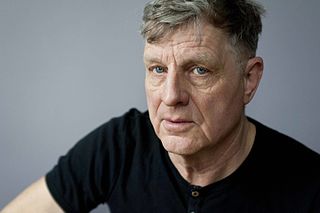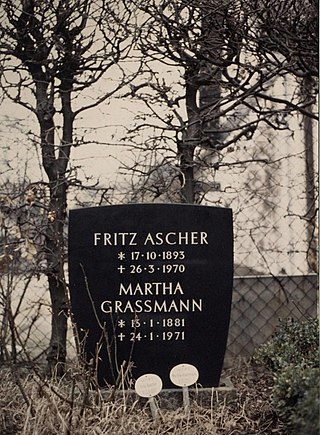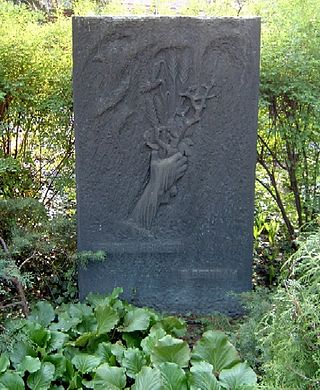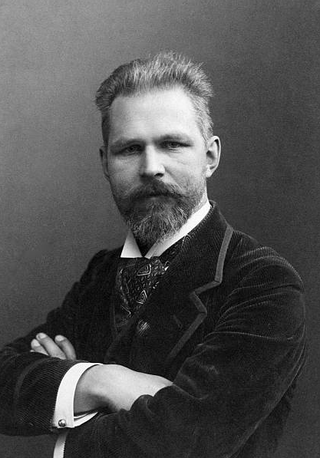Related Research Articles

Emil Nolde was a German-Danish painter and printmaker. He was one of the first Expressionists, a member of Die Brücke, and was one of the first oil painting and watercolor painters of the early 20th century to explore color. He is known for his brushwork and expressive choice of colors. Golden yellows and deep reds appear frequently in his work, giving a luminous quality to otherwise somber tones. His watercolors include vivid, brooding storm-scapes and brilliant florals.

Degenerate art was a term adopted in the 1920s by the Nazi Party in Germany to describe modern art. During the dictatorship of Adolf Hitler, German modernist art, including many works of internationally renowned artists, was removed from state-owned museums and banned in Nazi Germany on the grounds that such art was an "insult to German feeling", un-German, Freemasonic, Jewish, or Communist in nature. Those identified as degenerate artists were subjected to sanctions that included being dismissed from teaching positions, being forbidden to exhibit or to sell their art, and in some cases being forbidden to produce art.

In art history, secession refers to a historic break between a group of avant-garde artists and conservative European standard-bearers of academic and official art in the late 19th and early 20th century. The name was first suggested by Georg Hirth (1841–1916), the editor and publisher of the influential German art magazine Jugend (Youth), which also went on to lend its name to the Jugendstil. His word choice emphasized the tumultuous rejection of legacy art while it was being reimagined.

Karl Christian Ludwig Hofer or Carl Hofer was a German expressionist painter. He was director of the Berlin Academy of Fine Arts.
Burghart Schmidt was a German philosopher. He was professor at Hochschule für Gestaltung Offenbach and the University of Applied Arts Vienna.

Rainer Fetting is a German painter and sculptor.

Fritz Ascher was a German artist, whose work is characterized by Expressionist and Symbolist sensitivity. In paintings, works on paper and poetry he explored existential questions and themes of contemporary social and cultural relevance, of spirituality and mythology. Ascher's expressive strokes and intense colors create emotionally intense and authentic work.

The Militant League for German Culture, was a nationalistic anti-Semitic political society during the Weimar Republic and the Nazi era. It was founded in 1928 as the Nationalsozialistische Gesellschaft für deutsche Kultur by Nazi ideologue Alfred Rosenberg and remained under his leadership until it was reorganized and renamed to the National Socialist Culture Community in 1934.

Anna Blume and Bernhard Johannes Blume were German art photographers. They created sequences of large black-and-white photos of staged scenes in which they appeared themselves, with objects taking on a "life" of their own. Their works have been shown internationally in exhibitions and museums, including New York's MoMA. They are regarded as "among the pioneers of staged photography".

Hanns Diehl was an Austrian artist influential as the founder of Vienna's Künstlerbund Segantini (1921–1938).

Annot, also known after her marriage as Annot Jacobi, was a German painter, art teacher, art writer and pacifist. As a result of political hostility in Germany, she spent much of her life in the United States and Puerto Rico.
Marc Jung is a German painter and artist. He is based in Berlin and Erfurt.
Walter August Wilhelm Schulz was a German cellist, viol player and college teacher. From 1945 to 1948 he was director of the Hochschule für Musik Franz Liszt, Weimar.

Heinrich Ehmsen was a German painter and graphic artist.
Wilhelm Carl Melchior Simmler was a German painter and illustrator of the Düsseldorf school of painting.
Hans Wilhelm Hupp (1896–1943) was a German art historian, author and curator. From 1933 to 1943 he directed the Museum Kunstpalast of the city of Düsseldorf..
Max Creutz was a German art historian and curator of the Museum für Angewandte Kunst Köln and the Kaiser-Wilhelm-Museum in Krefeld where he worked from 1922 until his death. In Cologne, in 1914 he was instrumental in the first exhibition of the Deutscher Werkbund, Deutsche Werkbundausstellung. In Krefeld, he succeeded in acquiring modern art exhibits, including works by Max Ernst, Wassily Kandinsky, and Alexej von Jawlensky. He included a substantial collection of art, crafts and design from the Bauhaus.

August Ludwig Georg Meyn was a German portrait and genre painter.
Hugo Haberfeld, was an Austrian Jewish art dealer, who owned the Miethke Gallery in early 20th century Vienna. When Austria joined Nazi Germany in the 1938 Anschluss, Haberfeld fled to Paris.
Sunflowers is an oil-on-canvas painting by the German-Danish painter Emil Nolde, created in 1926. It was the first in a series of sunflower paintings, and also the first of more than fifty oil paintings on the same subject in Nolde's work. The sunflowers where a prominent motif among his flower paintings. The current painting has the dimensions of 72 by 90 cm, and is signed on the lower right edge of the canvas. It is held now in the Nolde Stiftung Seebüll.
References
- ↑ Bernhard Fulda, in W. Ruppert (coordinator), Künstler im Nationalsozialismus, Die "Deutsche Kunst", Die Kunstpolitik und der Die Berliner Hochschule, Vienna, Cologne, Weimar, 2015, p. 263 (German)
- ↑ Bernhard Fulda, in W. Ruppert (coordinator), Künstler im Nationalsozialismus, Die "Deutsche Kunst", Die Kunstpolitik und der Die Berliner Hochschule, Vienna, Cologne, Weimar, 2015, p. 270 (German)
- ↑ Emil Nolde, Mein Leben, Cologne, 2000, p. 394 (German)
- ↑ Bernhard Fulda, in W. Ruppert (coordinator), Künstler im Nationalsozialismus, Die "Deutsche Kunst", Die Kunstpolitik und der Die Berliner Hochschule, Vienna, Cologne, Weimar, 2015, p. 276 (German)
- ↑ Bernhard Fulda, in W. Ruppert (coordinator), Künstler im Nationalsozialismus, Die "Deutsche Kunst", Die Kunstpolitik und der Die Berliner Hochschule, Vienna, Cologne, Weimar, 2015, p. 271 (German)
- ↑ Manfred Reuther, in Emil Nolde-Ungemalte Bilder, Ostfildern, o. J. (German)